The color of soap bubbles
Where does the color of the bubbles come from?

Take an extra look into the phenomenon behind the colors of soap bubbles
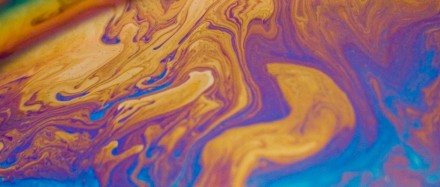
Where does the color of the bubbles come from?
This page is based on the basic page The color of soap bubbles. So if you have not read it yet, it might be a good idea to start with the link to the right :)
Light can be described as waves. The wave height (amplitude) corresponds to the intensity of the ray of light and the wave length (distance from one peak to the next) corresponds to the color.
Light is the type of wave we call electromagnetic waves. As illustrated in the figure below, the visible light is only a small part of the electromagnetic wave range, also containing radio waves, X-rays, and ultra violet light. The human eye can se light with wave lengths in the range of approximately 380 nm (violet) to 740 nm (red)
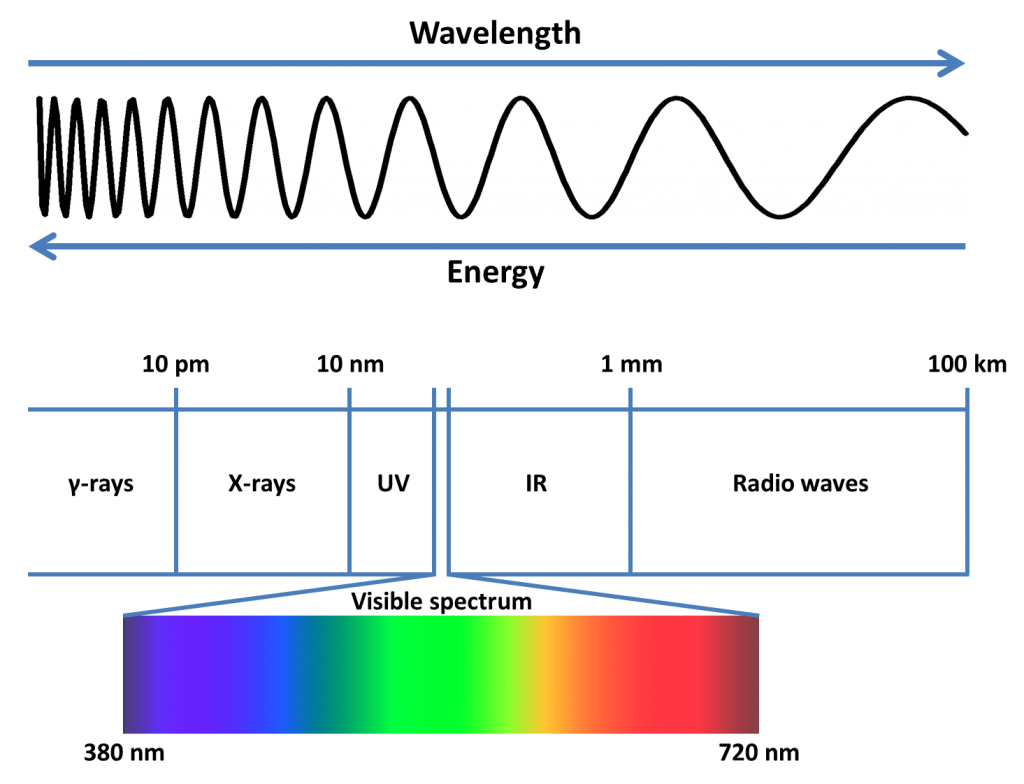
The electromagnetic spectrum with focus on the visible light
Let us focus on the special case where two waves of light with the same wavelength is following the same path. Then we will not perceive them as two, but as one wave. We say it it constructive interference when the waves enhance each other, i.e. the amplitude is larger than any of the original waves. Total constructive interference happens when the waves are in phase (peak over peak as illustrated to the left below). We say that the waves are out of phase, when one wave is shifted with regard to the other wave. It is called destructive interference, when the resulting wave has a smaller amplitude than one of the original waves. Total destructive interference happens when the waves in anti-phase (peak over trough as illustrated to the right below).
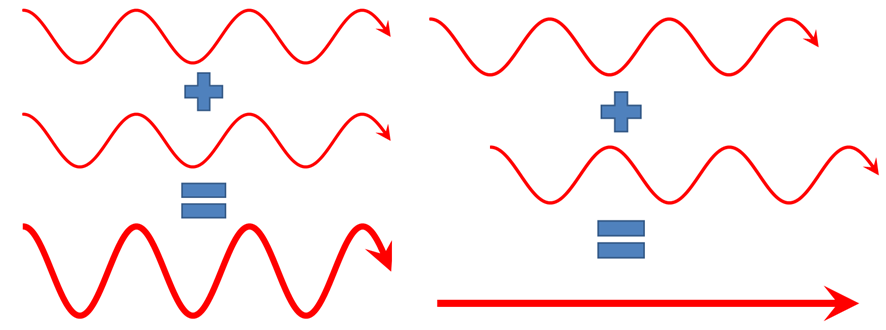
Total constructive interference and total destructive interference
Notice that total destructive interference only happens, when the waves have similar amplitudes, which is close to being the case for the reflections in a soap film. Additionally, it is important to remember that total destructive interference will result in the absence of light, which will be perceived as black areas on the soap film.
The colors of a soap film are therefore due to the interference of the original incoming light. When the incoming ray only have one color (corresponding to one wave length) a variation between constructive and destructive interference can be observed in the soap bubble. What we will see is a variation of the color and black which is related to the thickness of the soap film (See the previous images).
The colors in soap bubble are similar to, but not exactly identical to the colors in a CD, a prism or a rainbow. As explained above, the colors in soap bubbles is a wave interference phenomena, on the contrary the colors in a CD, a prism or a rainbow is due to dispersion of the light rays. The prism for example spreads out the colors of the white light, so that the colors from a prism are one wavelength (corresponding to one colors) is observed at each different point in the prism. The colors in the rainbow or prism are therefore pure colors, which means that they represent only one wave length. The colors in soap bubbles on the other hand, can contain many different wavelengths. They are therefore not pure, but mixed colors. For this reason it is possible to see colors in a soap bubble that are not found in a rainbow and vice versa. Thin film interference are also known from oil on puddles and some holograms.
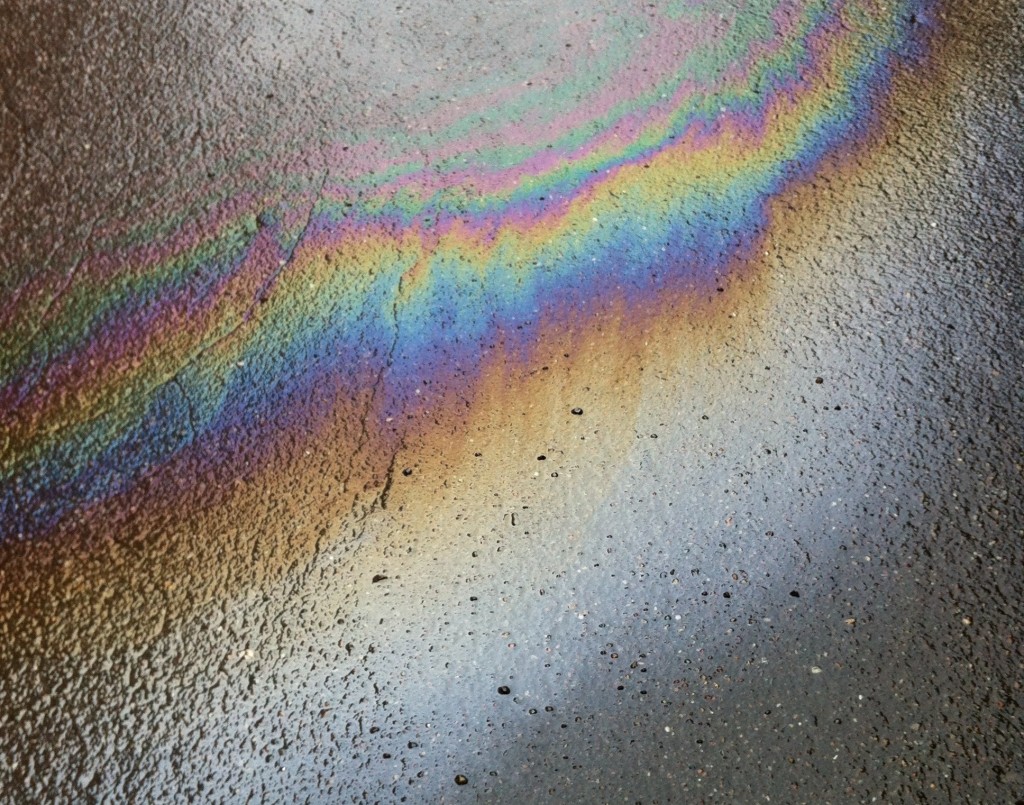
A thin film of oil on water show interference colors similar to those found in soap bobbles
From this point the text might be a bit hardcore, so you can choose to go directly to the part about the relation between the film thickness and the colors. You can of course also choose to scroll down and see if something catches your eye and just ignore the equations.
A soap film is an optical thin film, which is a film with a thickness comparable to the wavelength of light. A soap film only reflect a small fraction of the incoming light since it is far from a perfectly reflecting surface. A ray of light reflected and transmitted (going through) a soap film is illustrated below.
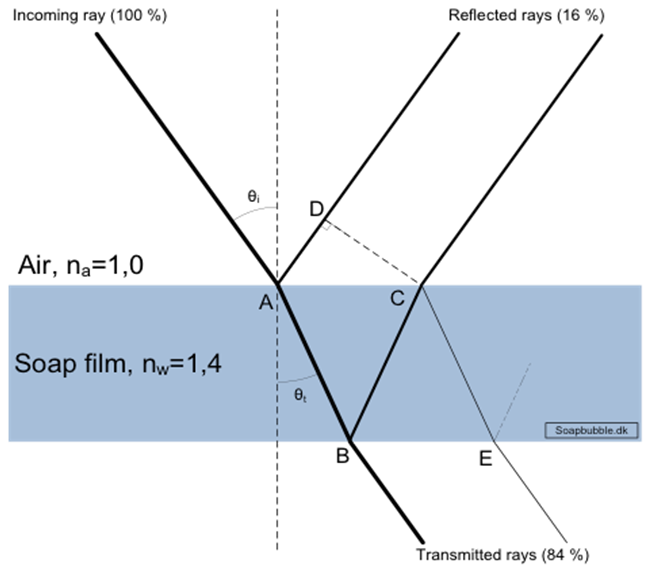
The first few reflections and transmissions of light in a soap film
The incoming light is reflected and transmitted in points A, B, C og E in the figure above. Here only the first two outgoing rays of reflection and transmission are included, but in principle there will be an unlimited number of reflections/transmissions with strongly decreasing intensity.
The difference of the so-called optical paths for the to outgoing rays define the type of interference. The optical path is defined as the physical distance the light ray travels multiplied with refractive index of the media it travels through. The relevant difference of the optical paths here are: the difference between the distance from A to D multiplied by the refractive index of air and from A over B to C multiplied by the refractive index of air soap film liquid. The optical path of the latter depends on the thickness of the film, the angle of incidence [latex] \theta _{i} [/latex], the refractive index of the film (and the air), and the wavelength of the light (i.e. the color of the light).
The optical path [latex] \left[p\right][/latex] (e.g. A-B-C), is given by the formula:
[latex] \left[p\right] = 2nd \: cos\theta _{i}[/latex]
where [latex] n [/latex] is the refractive index of the film, [latex] d [/latex] is the thickness of the film, and [latex] \theta _{i} [/latex] is the angle of incidence with respect to the normal of the film.
The incoming light is partly reflected at the surface of the film in the point A, while the major part is transmitted and continue to the opposite side of the film. In point B, some of the light is once again reflected (towards C), while about 84 % of the original light is transmitted. Notice that the directly transmitted light is many times more powerfull than the second light exiting the film at E. Therefore there will only be very weak interference between these two transmitted rays. It is therefore difficult, but possible to see transmitted colors from a soap bubble.
We here assume that all visible wave lengths are equally represented in the incoming light (which is almost the case for sun light) and that these are reflected equally well at all reflections. The reflected colors will then only depend on the constructive or destructive interference of the to outgoing rays. The thickness of a soap film is the most important parameter controlling the degree of constructive or destructive interference for each wave length. At some thicknesses for example the wave lengths corresponding to the color red are enhanced while blue reflections are damped.
An important point is that the phase of the incoming light wave is shifted for the reflection in A. The reason for this is that the soap film has a refractive index which is higher than the one for air. The result of the phase shift is that if the incoming wave has a peak at A, the transmitted ray towards B will start at a peak (as one might intuitively expect). But contrary to the this, the reflection towards D will start with a trough.
An interesting difference between the reflected and transmitted rays is that if a particular reflection color is enhanced by contructive interference, the same color will be damped for the transmitted rays by destructive interference. The reason for this is that the light travels the same distance from A to B to C compared to B to C to E and the phase shift only happens at point A. Therefore the strongest reflected colors will only be weakly transmitted and vice versa. The transmitted colors are therefore the complementary colors to the reflected colors.